|
Author
|
Message
|
|
charliemccraney
|
|
|
Group: Moderators
Last Active: Yesterday
Posts: 6.1K,
Visits: 443.0K
|
Might that sort of sizing difference benefit the street headers?
Lawrenceville, GA
|
|
|
|
|
Ted
|
|
|
Group: Administrators
Last Active: Last Month
Posts: 7.5K,
Visits: 205.8K
|
charliemccraney (5/5/2011)
Might that sort of sizing difference benefit the street headers?Charlie. You’re on the right track with that train of thought. What I’m finding is that the collector size itself as a general rule likes to merge down significantly and then expand back out to a larger size. For the dyno mule, the collector being necked down to 2.5” or thereabouts while the extension behind is larger. That larger section acts as an expansion chamber and helps to dampen some of the reverse pulsing that is trying to take place. Then using larger pipes behind this must be used to insure that the flow to the end of the exhaust is not being inhibited. This has been supported by the fact that the better test values always come about with the larger sized pipes being used. There are some real opportunities to be had in using high flow mufflers also. Many of the chambered mufflers that have been used thus far in the testing have been a detriment to overall performance. At this point, I suspect that the EMC headers could stand some additional downsizing on the merge collector. Right now it’s at 3” and at the time of testing on the EMC Y engine, that was the smallest merge collector on hand. In fact, Geoff Mummert supplied the one that’s in the headers now. I’ll also add that Jerry Christenson and Royce Brechler provided the original EMC headers which have only since been modified in the collector area.
  Lorena, Texas (South of Waco) Lorena, Texas (South of Waco)
|
|
|
|
|
jepito
|
|
|
Group: Forum Members
Last Active: 10 Years Ago
Posts: 87,
Visits: 541
|
Ted, do you have to run a chamber Muffler for the engine challenge? With our race engines we have found that a straight through glass pack style runs just as well as no muffler. shoenfield style hurts a little, and chamber style losing up to 80hp.
|
|
|
|
|
Ted
|
|
|
Group: Administrators
Last Active: Last Month
Posts: 7.5K,
Visits: 205.8K
|
jepito (5/14/2011)
Ted, do you have to run a chambered Muffler for the engine challenge? With our race engines we have found that a straight through glass pack style runs just as well as no muffler. shoenfield style hurts a little, and chamber style losing up to 80hp.Jepito. The only rules limitations for the EMC competition regarding mufflers dealt mainly with outlet sizes and overall dimensions. Actual muffler design could be varied as long as the muffler fit within the size dimensions specified in the rules. The mufflers used for the Y in the EMC competition were the Magnaflow straight through design and those particular mufflers with the other header modifications actually complimented the overall scoring for that particular combination. Although the peak horsepower does go up when the mufflers are removed from the headers, the scoring falls off significantly and the EMC competition is all about scoring, not peak numbers..
Here’s the link to the previous page showing both the horsepower and torque graphs using the EMC headers with and without the Magnaflow mufflers as compared to the Sanderson headers on the 312 dyno mule. The EMC headers with mufflers have a very favorable ‘very flat’ torque curve. http://forums.y-blocksforever.com/FindPost57447.aspx . And here’s the link to the thread that gives a better description of the EMC headers as well as a picture of both the EMC headers and Magnaflow mufflers. http://forums.y-blocksforever.com/Topic51508-3-2.aspx
  Lorena, Texas (South of Waco) Lorena, Texas (South of Waco)
|
|
|
|
|
Macs1964F100
|
|
|
Group: Forum Members
Last Active: 10 Years Ago
Posts: 12,
Visits: 177
|
Ted (3/27/2011)
Here’s some more information that adds two more sets of headers to the list of those that have already been tested. These were also tested on the same engine combination as all the other exhaust systems which keeps comparisons equal. Whereas only the best scores for each exhaust system were previously posted regardless of the number of configurations tested, here are the scores for each tested configuration for these two sets of headers. The scores are still based on the overall performance in the 2300-5500 rpm range. As in the previous tests, the mufflers continue to be appropriately sized based on the size of pipe that’s used in each test. In the FPA header test chart below, there were three different pairs of mufflers being used. The Ford Powertrain Applications (FPA) headers were unique in that the best numbers achieved were without any exhaust extensions being used and part of this could be attributed to the merge collector design being used at the ball shaped muffler connection at the end of the headers. Many of the headers being tested did like some form of exhaust extension in which to improve their overall performance. Crossover pipes were also tested and you can make your own assumptions based on the numbers. Sometime in the near future, I’ll post the lower rpm band information which is where the crossover pipes appears to make the most difference when comparing the graphs. FPA T-Bird 4 Tube 1.625”/1.75” stepped headers | Score | Peak HP | Peak TQ | Avg HP | Avg TQ | Mufflers | 2.25” pipes 64” long w/mufflers | 1738 | 298 | 346 | 238 | 322 | Yes | 2.25” pipes 64” long w/ no muffs | 1749 | 298 | 348 | 239 | 324 | No | 2.25” pipes 18” long w/ no muffs | 1761 | 306 | 352 | 242 | 325 | No | | 2.25” pipes 64” long & 2” dia crossover pipes and w/mufflers | 1735 | 300 | 347 | 238 | 321 | Yes | 2.25” pipes 64” long & 2” dia crossover pipes and w/ no muffs | 1757 | 303 | 349 | 241 | 325 | No | 2.25” pipes 18” long & 2” dia crossover pipes and w/ no muffs | 1761 | 304 | 352 | 242 | 325 | No | | 2½” pipes 64” long w/mufflers | 1748 | 297 | 348 | 239 | 323 | Yes | 2½” pipes 64” long w/ no muffs | 1757 | 297 | 349 | 241 | 325 | No | 2½” pipes 18” long w/ no muffs | 1763 | 306 | 354 | 242 | 325 | No | | 3” pipes 64” long w/mufflers | 1748 | 300 | 346 | 240 | 323 | Yes | 3” pipes 64” long w/ no muffs | 1764 | 303 | 349 | 242 | 326 | No | 3” pipes 18” long w/ no muffs | 1774 | 308 | 356 | 244 | 328 | No | | No pipes – open headers | 1780 | 311 | 342 | 244 | 329 | No |
Roadster 1.75” tubes 31” long with 18” long 3” dia collectors & no mufflers | Score | Peak HP | Peak TQ | Avg HP | Avg TQ | Without evacuation system hooked up | 1768 | 307 | 354 | 243 | 327 | With evacuation system hooked up | 1778 | 309 | 355 | 244 | 329 |
Ted, did you post the lower RPM results for these test? I have a 64 F100 and would like to update the exhaust to maximize lower torque.
|
|
|
|
|
Ted
|
|
|
Group: Administrators
Last Active: Last Month
Posts: 7.5K,
Visits: 205.8K
|
Ted, did you post the lower RPM results for these test? I have a 64 F100 and would like to update the exhaust to maximize lower torque. See if this set of graphs helps. This info actually indicates that it may be better in this particular instance to not use the crossover pipes in the exhaust on an engine that's simply running at the lower rpm band most of the time. My own experience with crossover pipes on daily drivers is that they do mellow out the exhaust notes on a V8 and stop some of the ‘popping’ noises that can occur out of the end of the pipes while cruising. .  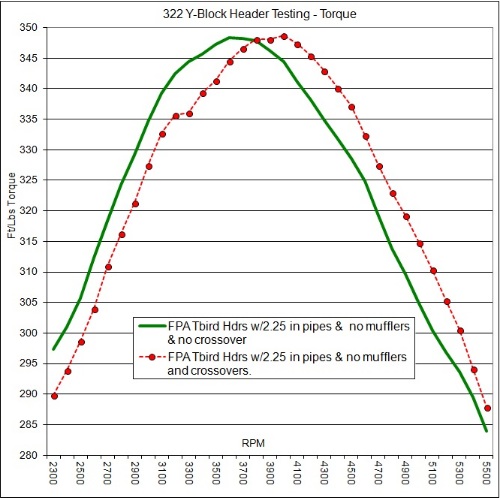 . 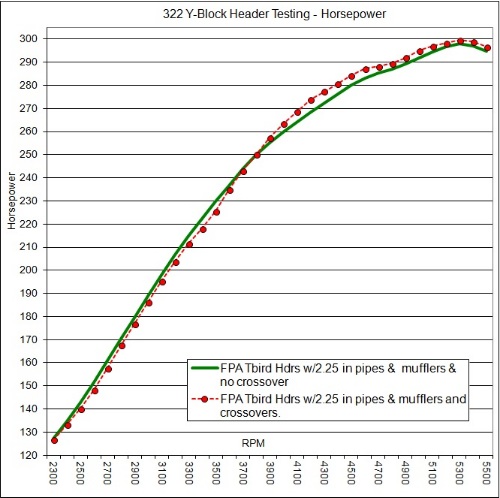 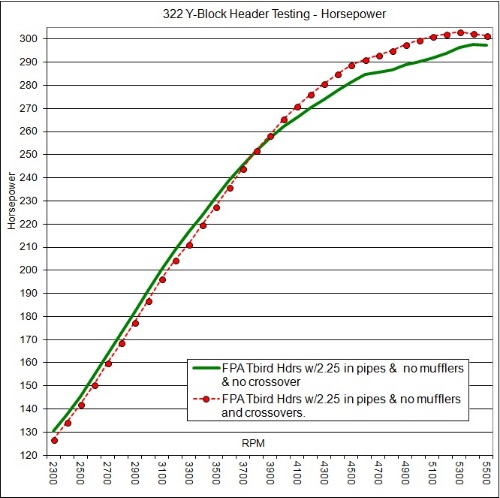
  Lorena, Texas (South of Waco) Lorena, Texas (South of Waco)
|
|
|
|
|
Macs1964F100
|
|
|
Group: Forum Members
Last Active: 10 Years Ago
Posts: 12,
Visits: 177
|
Thank you for the information and all of your contributions to the Y Block commiunity. I look forward to reading your post whenever I log on. My quest is for power in the 1000-3000 range and it looks like the cross over is shifting power ever so slightly upward. A good mellow sound is also good so I will start with the ram horns go from there. I am considering a "h" configuration for the exhaust with the tail pipe exiting behind the passenger rear tire. Do you have any recomendations on pipe sizing for an engine that will never turn more than 3500?
|
|
|
|
|
LordMrFord
|
|
|
Group: Forum Members
Last Active: 4 Years Ago
Posts: 687,
Visits: 9.3K
|
Ted (10/7/2013)
My own experience with crossover pipes on daily drivers is that they do mellow out the exhaust notes on a V8 and stop some of the ‘popping’ noises that can occur out of the end of the pipes while cruising.
True.
I like more my non-crossover Y-Block sounds in Fairlane than the sounds of injection era Mustang with crossover. You can hear Y-BLock beat in stereo while standing behind the car.

Hyvinkää, FI
|
|
|
|
|
Ted
|
|
|
Group: Administrators
Last Active: Last Month
Posts: 7.5K,
Visits: 205.8K
|
Macs1964F100 (10/12/2013)
...... Do you have any recomendations on pipe sizing for an engine that will never turn more than 3500? While a normal thought process might indicate that the smaller sized pipes would enhance lowend torque production, dyno testing that was performed on a Y engine with the different sized pipes indicates otherwise. Here are the graphs showing HP & TQ attributes with the different sized tail pipes installed on the 322” dyno mule. . 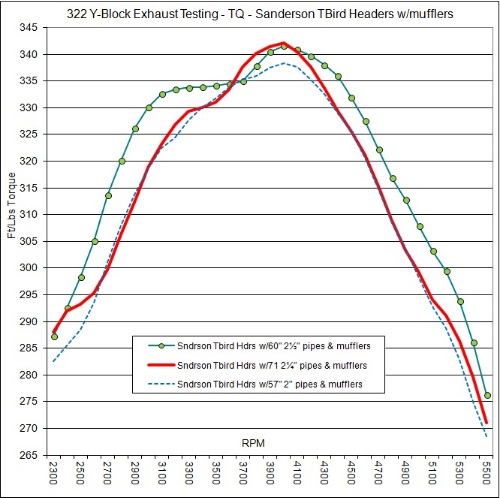 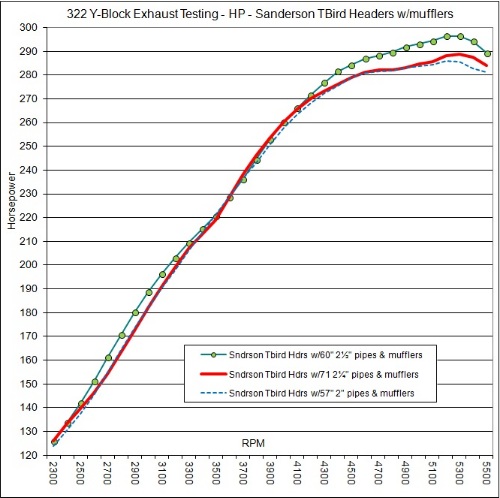
  Lorena, Texas (South of Waco) Lorena, Texas (South of Waco)
|
|
|
|
|
yalincoln
|
|
|
Group: Forum Members
Last Active: 2 Years Ago
Posts: 378,
Visits: 4.8K
|
damn! what she said, bigger is better!!! say ted, did you ever test those big tube headers on anything?
lincoln/merc. y-blocks &mel's bucyrus, ohio.
|
|
|
|